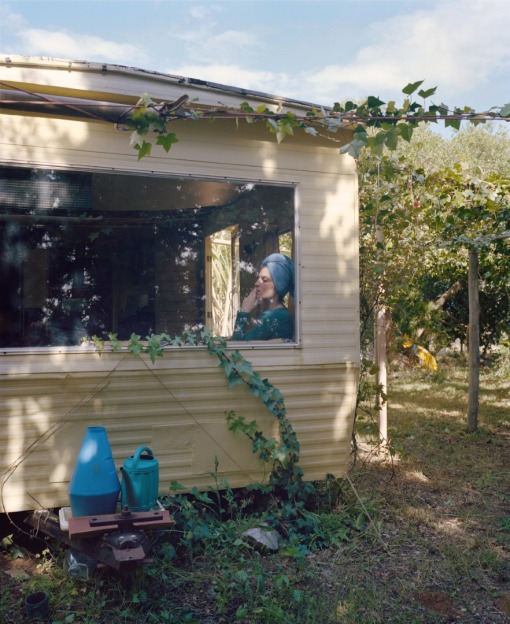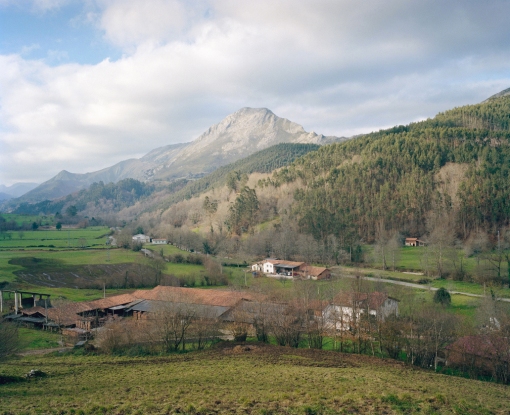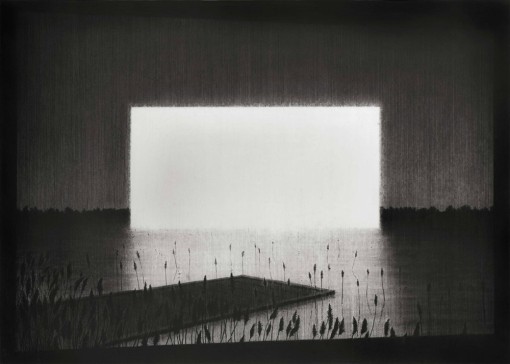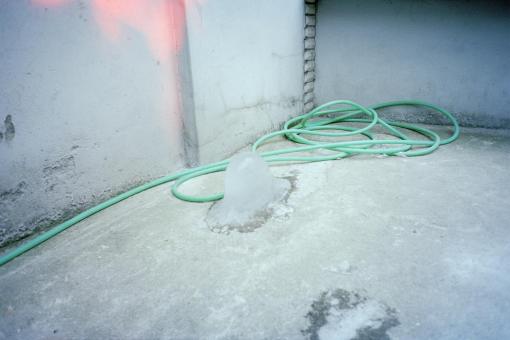Country Fictions. Juan Aballe
La ilusión de escapar de la sociedad contemporánea, los mitos y esperanzas construidos alrededor de la naturaleza se unen a la extrañeza y la nostalgia de mirar a una vida que quizás nunca llegue a vivir.
Es prácticamente seguro que las buenas fotografías surgen de las palabras, de las palabras bien dichas. Lo que ocurre, lo que acontece, genera palabras, a continuación llegan las fotografías. Es necesario hablarlo antes, es muy difícil hacer fotografías sin haberlo dicho antes, es complicado ver sin decir. Ver es hablar con una cámara, es necesario el universo de las palabras y también el de la visión, tan diferentes, son profesiones diferentes. Para ver es necesario ser fotógrafo, ello implica un decir visual, un expresar sin palabras, un idioma que muestra pero no explica, tan sólo el poder de lo visual, es necesario un pensamiento visual, lo visto sin ser descifrado, no se habla como lo hacen los escritores de palabras, no es traducible. Es necesario ser fotógrafo. Una vez conseguido ello, comienza nuestra narración.
Eduardo Momeñe, ensayo sobre Country Fictions.
¿Qué te impulsó a comenzar Country Fictions?
El proyecto surgió en un momento de mi vida en que varios amigos se planteaban ir a vivir al campo y esa idea se convirtió en una opción real. Era un pensamiento que en parte me ilusionaba, pero también sentía que mi relación con la naturaleza tenía una fuerte carga de idealización. Country Fictions se fue convirtiendo en una manera de explorar mi relación con el medio rural y de lidiar con esos sentimientos contradictorios desde lo visual.
La fotografía me permitía también lanzar al aire muchas preguntas que yo mismo me hacía al respecto y reflexionar sobre varios temas que me interesaban. Desde el concepto de paisaje o el abandono del campo hasta la necesidad humana de creer en algo mejor, todos ellos son hilos conductores del proyecto.
¿Ha cambiado la relación que tenías con la naturaleza después de hacer este trabajo?
Más que cambiar mi relación con la naturaleza creo que a través del proyecto he logrado comprender mejor esa relación. La realización y la edición de las imágenes durante varios años implica ir tomando muchas decisiones, de manera que el trabajo fotográfico al final define mucho más a quien toma esas decisiones que al mundo que fotografía. En ese sentido Country Fictions ha sido un proceso de aprendizaje.
Además de las imágenes, la vivencia personal, los lugares y las personas que he conocido también me han enseñado mucho. Indagar en la relación con la naturaleza lleva a preguntarse sobre las necesidades sociales y personales, la gestión del tiempo, el trabajo o la capacidad de renunciar a ciertas cosas.
¿Cómo te diste cuenta de que el trabajo ya estaba terminado?
Llegó un momento en el que sentí que todo lo que quería decir estaba dicho, estaba en los negativos. A partir de entonces se trataba de empezar a descartar elementos e ir a lo esencial. Mi objetivo era hablar desde la sencillez para lograr transmitir emociones a veces complejas.
El proceso de edición fue bastante largo ya que decidí dejar reposar las imágenes y enfrentarme a ellas semana tras semana durante meses para saber de cuáles podía prescindir y cuáles aguantaban el paso del tiempo. Por otro lado el reto era encontrar un equilibrio en la selección y secuenciación de las imágenes que comunicara lo que yo quería pero dejara suficiente espacio de interpretación al espectador. Podría haber seguido editando indefinidamente pero después de un año decidí que tenía que sacar el proyecto a la luz. Hablando de su proceso creativo en el cine, Jim Jarmusch recordaba una cita de Paul Valéry que decía: “Un poema nunca se termina, sólo se abandona”. Creo que esa idea define bastante bien mi experiencia con la edición de Country Fictions.
¿Qué influencias has tenido a lo largo de este proyecto?
Cuando comencé con Country Fictions estaba muy interesado en el paisaje como construcción cultural. La primera fotografía que realicé del proyecto es el paisaje que aparece en primer lugar y fue la que me animó a seguir adelante durante los primeros meses. Me interesó mucho el libro Breve tratado del paisaje de Alain Roger, que habla del paisaje como “artealización” ajena a la naturaleza. Gracias a un taller con Simon Norfolk empecé también a interesarme por la simbología de los paisajes de Claude Lorrain y su influencia en los románticos o los pintores de la Escuela del Río Hudson.
En cuanto a los retratos, las influencias creo que son más fotográficas, con numerosas referencias a la tradición documentalista que traslado al contexto del proyecto.
Es difícil hablar de autores en concreto porque las influencias visuales y literarias son muy diversas y evolucionan a lo largo del tiempo. Pero si tuviera que elegir una novela probablemente sería La carretera, de Cormac McCarthy.
Recomiéndanos un libro.
El antropólogo inocente de Nigel Barley. Es la crónica de un etnógrafo británico que se traslada a África para convivir con una tribu poco conocida. Aunque aparentemente no tenga nada que ver, creo que es un libro muy recomendable para fotógrafos.
Country Fictions acaba de ser publicado por Fuego Books, una editorial de fotolibros lanzada por Ángela y Gustavo Alemán cuya intención es hacer «libros hermosos, libros peligrosos, libros que queman.» Con Country Fictions, su primera publicación, lo han conseguido y ya ha entrado en la lista de los 35 mejores fotolibros del año de Andy Adams y está entre los 10 favoritos de C.A.P.E
Web de Juan Aballe




















































